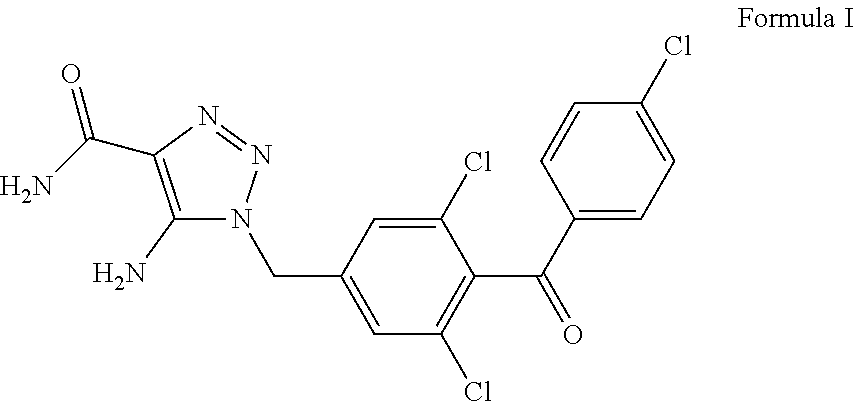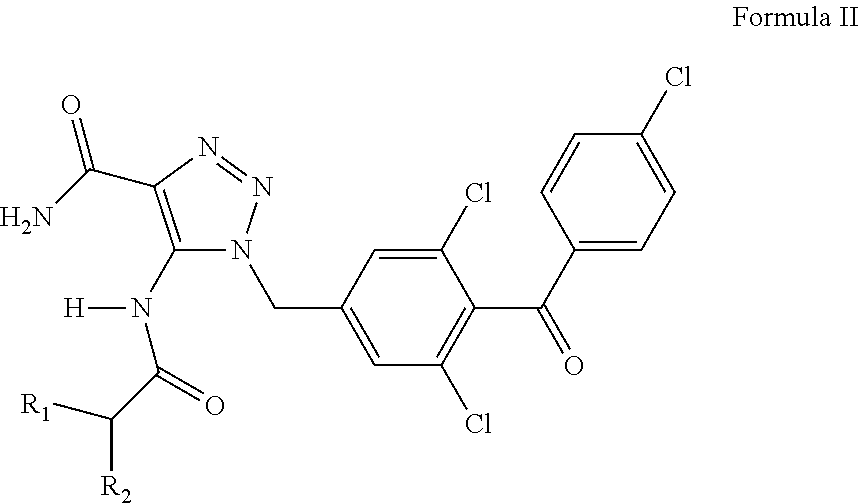Cai-based systems and methods for the localized treatment of uveitis
- Summary
- Abstract
- Description
- Claims
- Application Information
AI Technical Summary
Benefits of technology
Problems solved by technology
Method used
Image
Examples
example 1
Procedures for Preparing and Identifying Stable, Autoclavable Aqueous Formulations of CAI Compounds
General Procedure
[0202]Amorphous solid free base form of CAI active pharmaceutical ingredient having Formula I (5-amino-[4-(4-chlorobenzoyl)-3,5-dichlorobenzyl]-1,2,3-triazole-4-carboxamide), which can be synthesized by one skilled in the art of organic chemistry according to procedures described in U.S. Pat. Nos. 4,590,201 and 5,602,156, is first dissolved in a minimal volume of absolute ethanol at 40° C. Additives are added to this solution as selected from an ionic surfactant (preferably a lipophilic organic acid having at least 8 carbon atoms such as oleic acid), an organic oil, such as alkyl ester of fatty acid and / or monoglyceride, diglyceride, or triglyceride, or glyceride (e.g. soybean oil, or mixtures thereof), and other organic solubilizing additives (e.g. Tweens, Pluronics, cyclodextrins, polysorbates, sorbitan esters, sucroesters, and other non-ionic surfactants, polyethyle...
example 2
Intravitreal Injection
[0211]Pharmacologically effective concentrations in diverse in vitro and in vivo model systems of CAI at 0.5 to 10 micromolar concentration which is consistent with a dose of 0.2 ng to 40 ng of drug in a compartment of about 4 to 5 mL for the eye for a long term 4 to 6 week maintenance of a controlled dose use with indicate a dose range of 50 ng to 500 ng of CAI active ingredient or greater.
[0212]The intravitreal injection would be administered via the inferotemporal pars plana, in a protocol similar to triamcinalone, Macugen®, or Lucentis®. As a single dose of 5 mg of dexamethasone-administered subconjunctivally can reach micromolar concentrations in the subretinal space and vitreous, and CAI possesses similar trans-scleral permeability kinetics, an initial dose of 5 to 50 mg for periocular administration is proposed. An effective quantity of the compound of interest is employed in treatment.
[0213]As understood by the skilled clinician, the dosage of compounds...
example 3
Single Ingredient Formulation
[0214]Ingredient Concentration w / v % CAI 0.1 to 2% Monobasic Sodium Phosphate Dihydrate 0.051% Dibasic Sodium Phosphate Dodecahydrate 0.5% Tyloxapol 0.05-0.4% Sodium Chloride 0.76% NaOH / HCl pH adjust to 5.0-8.4 Water for injection q.s. 100%.
PUM
| Property | Measurement | Unit |
|---|---|---|
| Time | aaaaa | aaaaa |
| Antimicrobial properties | aaaaa | aaaaa |
Abstract
Description
Claims
Application Information
 Login to View More
Login to View More - R&D
- Intellectual Property
- Life Sciences
- Materials
- Tech Scout
- Unparalleled Data Quality
- Higher Quality Content
- 60% Fewer Hallucinations
Browse by: Latest US Patents, China's latest patents, Technical Efficacy Thesaurus, Application Domain, Technology Topic, Popular Technical Reports.
© 2025 PatSnap. All rights reserved.Legal|Privacy policy|Modern Slavery Act Transparency Statement|Sitemap|About US| Contact US: help@patsnap.com



